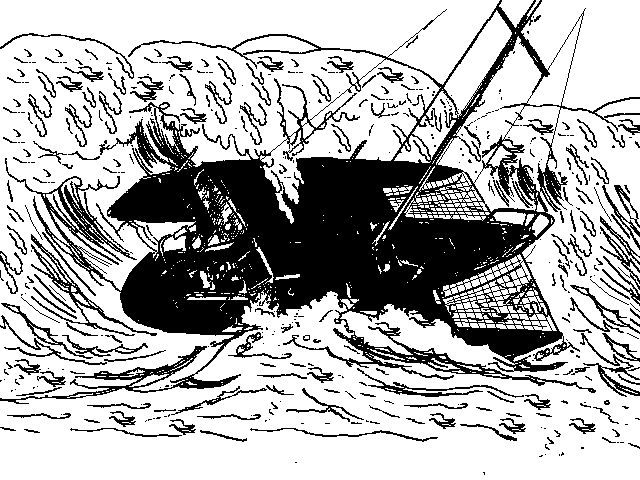Trimaran, Searunner
37' x 22' x 5.5 Tons
18-Ft. Dia. Sea Anchor
Force 8-9 Conditions
File S/T-13, obtained from Brian Hunt, Sacramento, CA. - Vessel name Born Free, hailing port Ventura CA, Searunner trimaran, designed by Jim Brown, LOA 37' x Beam 22' x Draft 6'11" (3' board up) x 5.5 Tons - Sea anchor: 18-ft. Diameter Para-Tech on 400' x 5/8" nylon braid tether and bridle arms of 100' each, with stainless steel 5/8" swivel - Full trip line - Deployed in a gale in 450 fathoms off the coast of Mexico with winds of 40 knots and seas of 20 ft. - Vessel's bow yawed 10° - Drift was 4.25 n.m. during 20 hours at sea anchor.
Brian and Trina Hunt were sailing Born Free from California to Norway, via Tahiti. In the trip down to Cabo San Lucas Born Free ran into nasty conditions off the coast of Mexico. Transcript:
We were actually having our best sail since the start of our voyage, nearly straight downwind with a single reef in the main and traveling along quite nicely with occasional surfs, which although exhilarating were not at all frightening. This was early in the morning and as the hours went by the wind continued to increase and the waves built in size until - under stays'l alone - we were surfing regularly down the faces of the waves which I would estimate to be 10-15' with very steep and sometimes breaking faces. It was really no fun anymore and with the conditions deteriorating I decided it was time to try the sea anchor. Deployment went well, using the DSB (deployable stowage bag), except for the tripline which fouled and had to be cut. We came bow-to the seas and the boat rode nicely. This was around 1:00 in the afternoon. As the day wore on the conditions continued to worsen and by nightfall I would estimate that the waves were in the 15-25' range, very steep and frequently breaking. The strongest winds and seas occurred at night, and not being able to see the surface of the water I could only estimate the wind at being something over 40 knots. Later, we met a vessel which had been in the same blow and they reported that their wind indicator was pegged at 60 knots for over 8 hours.
During the worst part of the storm we would sometimes be hit from the side by a large sea and it would knock our bow approx 60° off the dominant train. It would take the boat about 10-15 seconds to fetch up on the sea anchor and turn bow-to the seas again. At first light the wind had dropped to about 25 kts and continued to drop through the morning. I then pulled the sea anchor in. We had no damage and had spent the duration of the blow in our bunks. This is not to say we weren't frightened - we were, right to our very cores. But what is really scary to me is the thought of trying to steer through that mess in the dark when you couldn't pick your way through the worst of the waves. We probably would have made it through, but at much greater risk and discomfort to our boat and ourselves.
I've since related this experience to many other sailors and I'm still amazed at the lukewarm attitudes toward sea anchors. I usually have to tell them three times that it was used off the BOW and not the stern! Most think it is a multihull tactic and not in the realm of monohulls. However, heaving-to, running off and lying a-hull all require searoom, the lack of which could mean disaster. Not to mention broaching, rolling over, pitchpoling. Why risk these things?

